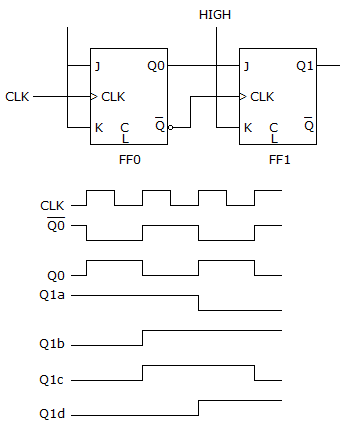Discussion
Home ‣ Digital Electronics ‣ Code Converters and Multiplexers Comments
- Question
How is an encoder different from a decoder?
Options- A. The output of an encoder is a binary code for 1-of-N input.
- B. The output of a decoder is a binary code for 1-of-N input.
- Correct Answer
- The output of an encoder is a binary code for 1-of-N input.
- 1. A ripple counter's speed is limited by the propagation delay of:
Options- A. each flip-flop
- B. all flip-flops and gates
- C. the flip-flops only with gates
- D. only circuit gates Discuss
- 2. A MOD-12 and a MOD-10 counter are cascaded. Determine the output frequency if the input clock frequency is 60 MHz.
Options- A. 500 kHz
- B. 1,500 kHz
- C. 6 MHz
- D. 5 MHz Discuss
- 3. For a multistage counter to be truly synchronous, the ________ of each stage must be connected to ________.
Options- A. Cp, the same clock input line
- B. CE, the same clock input line
- C.
 , the terminal count output
, the terminal count output - D.
 , both clock input lines
Discuss
, both clock input lines
Discuss
- 4. Which segments (by letter) of a seven-segment display need to be active in order to display a digit 6?
Options- A. b, c, d, e, f, and g
- B. a, c, d, e, f, and g
- C. a, b, c, d, and f
- D. b, c, d, e, and f Discuss
- 5. The circuit given below has no output on Q1 when examined with an oscilloscope. All J-K inputs are HIGH, the CLK signal is present, and the Q0 is toggling. The C input of FF1 is a constant LOW. What could be causing the problem?

Options- A. The Q0 output should be connected to the J input of FF1.
- B. The output of FF0 may be shorted to ground.
- C. The input of FF1 may be shorted to ground.
- D. Either the output of FF0 or the input of FF1 may be shorted to ground. Discuss
- 6. Which of the following is not a weighted value positional numbering system:
Options- A. hexadecimal
- B. binary-coded decimal
- C. binary
- D. octal Discuss
- 7. What do the mathematical symbols A < b and A > B mean?
Options- A. A < B means A is greater than B. A > B means A is less than B.
- B. A > B means A is less than B. A < B means A is greater than B.
- C. A < B means A is less than B. A > B means A is greater than B. Discuss
- 8. What is the status of the inputs S0, S1, and S2 of the 74151 eight-line multiplexer in order for the output Y to be a copy of input I5?
Options- A. S0 = 0, S1 = 1, S2 = 0
- B. S0 = 0, S1 = 0, S2 = 1
- C. S0 = 1, S1 = 1, S2 = 0
- D. S0 = 1, S1 = 0, S2 = 1 Discuss
- 9. Most demultiplexers facilitate which type of conversion?
Options- A. decimal-to-hexadecimal
- B. single input, multiple outputs
- C. ac to dc
- D. odd parity to even parity Discuss
- 10. How many outputs are on a BCD decoder?
Options- A. 4
- B. 16
- C. 8
- D. 10 Discuss
Code Converters and Multiplexers problems
Search Results
Correct Answer: each flip-flop
Correct Answer: 500 kHz
Correct Answer: Cp, the same clock input line
Correct Answer: a, c, d, e, f, and g
Correct Answer: Either the output of FF0 or the input of FF1 may be shorted to ground.
Correct Answer: binary-coded decimal
Correct Answer: A < B means A is less than B. A > B means A is greater than B.
Correct Answer: S0 = 1, S1 = 0, S2 = 1
Correct Answer: single input, multiple outputs
Correct Answer: 10
Comments
There are no comments.More in Digital Electronics:
Programming
Copyright ©CuriousTab. All rights reserved.
